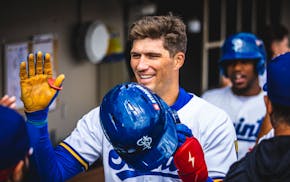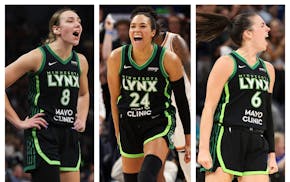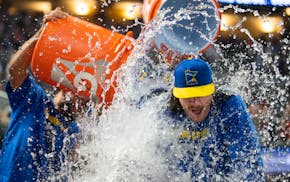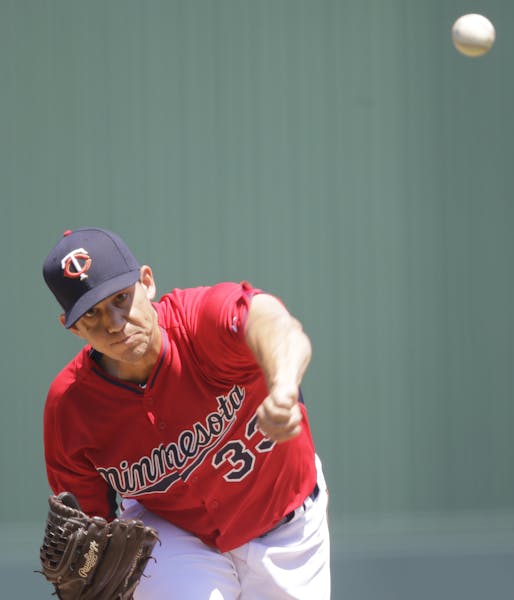FORT MYERS, FLA.
When the Twins hired Neil Allen in November, righthander Kyle Gibson looked for background information on his new pitching coach and was delighted to find out that Allen has helped numerous pitchers with developing the changeup.
"Our first conversation was like, 'Hey, I think I have a pretty good changeup that can be a weapon for me,' " Gibson said. " 'I use it against lefties right now but I would like to use it against righties too.' From there we talked more."
Allen, who came to the Twins following four seasons with Tampa Bay's Class AAA Durham team, has helped Rays pitchers such as Chris Archer and Alex Cobb with the change-of-pace pitch. Tampa Bay also is where James Shields became one of the best changeup pitchers in the game.
The enthusiastic Allen has met with numerous members of the Twins pitching staff, and whoever wants to make the pitch a larger part of their life, he's all for it.
"We're doing good right now," Allen said. "The thing we're trying to get right now is to where we are incorporating it more."
And the Twins are having some success with it this spring. Last week, Tampa Bay star Evan Longoria struck out swinging in the first, fourth and six innings against Gibson — twice on changeups. Afterward, Rays coaches, led by hitting coach Derek Shelton, used colorful language to complain to the 57-year-old Allen that he took their secrets with him when he left for the Twins.
"I brought a few things with me, but I didn't say yes or no to anything," Allen said. "[The changeup is] a hell of a pitch when it can be executed."
There's an infatuation with power arms and 100 mile-per-hour fastballs and nasty breaking pitches. A changeup is underappreciated but attacks a hitter's timing and can make them look silly. Shields has referred to the pitch as "the great equalizer."
Minor leaguers in the Twins farm system are required to learn a changeup if they don't have one. And sometimes it can take years to develop — see Alex Meyer.
Twins pitchers threw changeups only 8 percent of the time last season, according to the website FanGraphs. Kevin Correia, before he was traded Aug. 9, led Twins starters by throwing it 14.4 percent of the time. Tommy Milone, who pitched mostly for Oakland in 2014, threw the slowest one, an average of 79.5 mph.
Twins righthander Phil Hughes threw changeups only 0.2 percent of the time last season, according to FanGraphs, but he plans to add more to his pitching package this season.
"It is," Hughes said, "the best pitch in baseball."
Many grips
The changeup relies on deception. The arm movement is the same as a fastball, but the pitch comes in 8-10 mph slower — or at least, it's supposed to. For a hitter looking to square up a fastball, the change of speed can be too much to overcome. Twins pitchers with excellent changeups have included Frank Viola, Brad Radke and Johan Santana.
A good changeup can be a strikeout pitch but also can elicit weak ground balls or pop-ups. Pitchers use various grips to throw the pitch, and Allen is willing to teach them all. Some can just move a thumb over from their fastball grip for the desired effect.
Reliever A.J. Achter showed how he holds his fastball with the middle and ring finger over the top of the ball. To throw a changeup, he slides his index finger and pinkie finger higher up the sides.
Some pitchers can't get a feel for a change and use a split-fingered fastball as a changeup — Mike Pelfrey is trying one out this spring. Jared Burton, who pitched for the Twins last season, called his the splange.
There is also one called the Vulcan. Just imitate Spock's famous salute from "Star Trek," jam a baseball between the middle and ring finger and go for it.
Blaine Boyer, told Monday he earned a spot in the Twins bullpen, is working on a changeup with Allen's help. He admitted he held his breath when he threw it in an early spring game, but it found the plate for a strike.
"Neil taught me one that I'm excited to try out," Boyer said. "I've never had one that I can throw with conviction, and you can't be effective if you're tentative about throwing it. But I'm convinced if you can throw it exactly the same [as your fastball], it's absolutely a power pitch. You throw it off your fastball, you throw it in power situations, and it's a power pitch."
Picking your spot
It's not as simple for someone coming off a 16-win season to mix in a changeup. But Hughes is trying to do so.
"I get out in situations and I get competitive and I don't want to get beat with my fourth-best pitch," said Hughes, who has added and dropped numerous pitches throughout his career. "So I'm kind of stubborn, and Neil has to poke at me in the dugout to throw it more."
It's not just about throwing it. Allen used the word conviction over and over again as he explained what it takes to make the pitch effective.
"It's when you throw it and how you throw it," Allen said. "How you get the foot down and how you execute the arm action. You sell it. You sell it before you throw it."
Gibson experienced the dangers of a righthander throwing a changeup to a righthanded hitter when he tried to throw one to Pittsburgh's Francisco Cervelli on March 20. The pitch faded into the barrel of Cervelli's bat for a home run. Less than a week later, Gibson owned Longoria.
Allen wants the focus on keeping the changeup down and have it drop out of the strike zone.
"You don't have locate it on the black," he said. "You want to throw it right down the middle and sell out with the arm action to the bottom of the zone. Make it look like a two-seam fastball or a four-seam fastball, whatever you choose to do."
Since many pitchers traditionally won't throw a changeup to someone on the same side (right vs right, left vs left), that's one less pitch a hitter has to worry about. So Twins pitchers want batters to worry about the changeup, because that makes all their other pitches more effective.
Outfielder Torii Hunter, about to enter his 19th major league season, said what Twins pitchers are doing represents a trend.
"The past couple of years they are starting to throw righty-righty changeups," the righthanded-hitting Hunter said. "It's different, but it can be dangerous as well. If you leave it out over the plate, you have to be careful."
For a pitching staff trying to hold its own without a lot of fireballers, the changeup could end up being their great equalizer. Twins General Manager Terry Ryan likes the approach.
"I'm glad Neil is [encouraging the pitch], and I am hoping Paul [Molitor] is doing the same," Ryan said. "Encouraging them to use their arsenal down here so when they get up in the real world they will be able to go with that pitch more."

As the Loons prepare to face Lionel Messi and Inter Miami, what's this circus all about, anyway?

Twins power-hitting prospect drawing big-league attention

As Lynx 'run it back' this season, their bedrock is trio from the Class of '19

